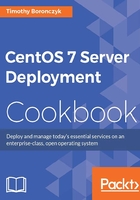
What this book covers
The recipes presented in this book aim to make even the most difficult configuration tasks easy by providing step-by-step instructions and discussion. Here's a quick rundown of what you can expect from each of the 12 chapters.
Chapter 1, Getting Started with CentOS, contains recipes for installing CentOS using graphical, text-based, and kick-start approaches. How to set up a CentOS platform for projects running Docker and on Amazon Web Services is also discussed.
Chapter 2, Networking, contains recipes to help you complete common networking tasks, such as how to set up a static IP address, assign multiple addresses to a single network interface, bond multiple interfaces with the same address, and configure the system's firewall using FirewallD and iptables. It also presents recipes for configuring network services such as DHCP, NFS, and Samba.
Chapter 3, User and Permission Management, shows you how to increase the security of your system by enforcing password restrictions, adjusting the default permissions given to newly created files and directories, and the use of sudo to avoid circulating the root password. How to work with SELinux is also discussed.
Chapter 4, Software Installation Management, provides recipes focused on working with software repositories and installing software. You'll learn how to register the EPEL and Remi repositories, prioritize the repositories packages are installed from, and update your software automatically. You'll also learn how to compile and install software from source code.
Chapter 5, Managing Filesystems and Storage, presents recipes that show you how to set up and work with RAID and with LVM. These services leverage your system's storage to maintain availability, increase reliability, and to keep your data safe against inevitable disk failures.
Chapter 6, Allowing Remote Access, aims to help you provide remote access to your CentOS system in a secure manner. Its recipes cover using SSH, configuring a chroot jail, and tunneling VNC connections through an encrypted SSH tunnel.
Chapter 7, Working with Databases, collects recipes that provide you with the necessary steps to get started with various database services such as MySQL, MongoDB, and OpenLDAP. You'll also learn how to provide backup and redundancy for these services.
Chapter 8, Managing Domains and DNS, takes us into the world of DNS. The recipes show you how to set up a resolving DNS server to decrease latency caused by domain lookups and how to manage your own domain with an authoritative DNS server.
Chapter 9, Managing E-mails, will help you set up your own mail server. The recipes discuss configuring Postfix to provide SMTP services, configuring Dovecot to provide IMAP and POP3 services, and securing these services with TLS. You'll also find instructions on how to set up SpamAssassin to help reduce unsolicited bulk e-mails.
Chapter 10, Managing Web Servers, contains recipes about configuring Apache to server web content. You'll learn how to set up name-based virtual hosting, server pages over HTTPS, and perform URL rewriting. How to set up NGINX as a load balancer is also discussed.
Chapter 11, Safeguarding Against Threats, contains recipes to help protect the investment you've made in your CentOS server. They cover logging, threat monitoring, virus and rootkits, and network backups.
Chapter 12, Virtualization, shows you how CentOS can function as a host operating system to one or more virtualized guests. This allows you to take better advantage of your hardware resources by running multiple operating systems on the same physical system.